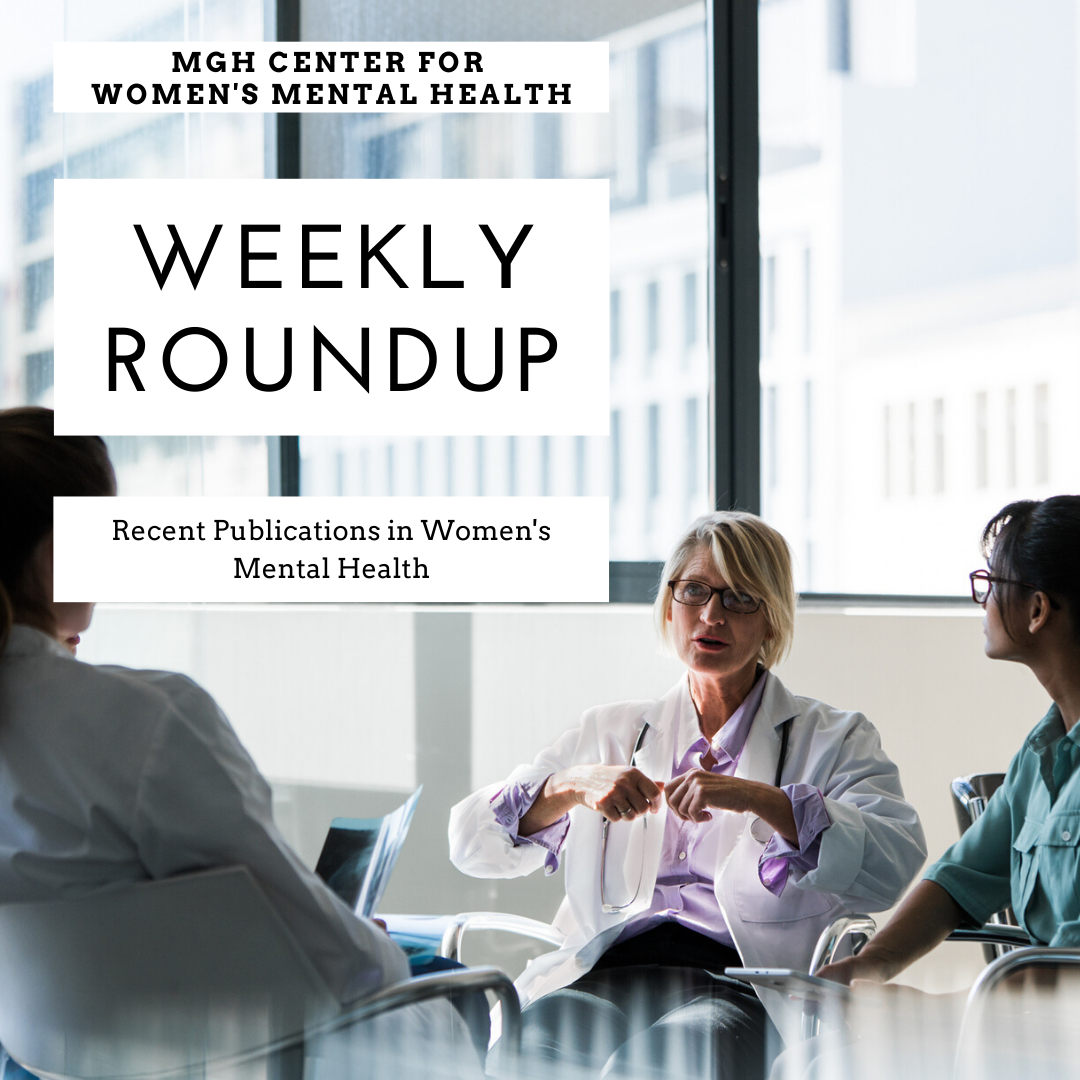
Every week we review the most recent publications in women’s mental health, covering topics related to premenstrual symptoms, perinatal mood and anxiety disorders, use of medications in pregnant and breastfeeding women, perinatal substance use, and menopausal mental health.
For more detailed descriptions of many of these topics, you can sign up to receive our weekly CWMH NEWSLETTER which comes out every Thursday.
Ruta Nonacs, MD PhD
PMS AND PMDD |
|
Nayman S, Konstantinow DT, Schricker IF, Reinhard I, Kuehner C. Arch Womens Ment Health. 2023 Mar 11. Higher habitual present-moment-awareness was linked to lower premenstrual symptom and impairment levels toward the late luteal phase whereas higher habitual acceptance was associated with lower premenstrual functional impairment (p ? .015). Premenstrual symptom increases during the late luteal phase in women with PMS seem to be linked to increased daily rumination and perceived stress.
|
INFERTILITY AND MENTAL HEALTH |
|
No articles this week
|
PSYCHIATRIC ILLNESS DURING PREGNANCY |
|
Roddy Mitchell A, Gordon H, Lindquist A, Walker SP, Homer CSE, Middleton A, Cluver CA, Tong S, Hastie R. JAMA Psychiatry. 2023 Mar 8:e230069. This meta-analysis found that depression was common in low- and middle-income countries, affecting 1 in 4 perinatal women. Leslie K, Barker LC, Brown HK, Chen S, Dennis CL, Ray JG, Saunders N, Taylor C, Vigod S. CMAJ. 2023 Mar 6;195(9):E322-E329. Overall, 137 (3.1%) of those with schizophrenia had a perinatal ED visit for interpersonal violence, compared with 7598 (0.4%) of those without schizophrenia, for an RR of 6.88 (95% confidence interval [CI] 5.66-8.37) and an adjusted RR of 3.44 (95% CI 2.86-4.15). Leiferman JA, Lee-Winn AE, Lacy R, Paulson JF. Womens Health Issues. 2023 Mar-Apr;33(2):175-181. A brief online training may enhance the likelihood of providers screening, treating, and/or referring at-risk patients for follow-up care for prenatal depression. The microbiota-gut-brain axis and perceived stress in the perinatal period. Long ES, Penalver Bernabe B, Xia K, Azcarate-Peril MA, Carroll IM, Rackers HS, Grewen KM, Meltzer-Brody S, Kimmel MC. Arch Womens Ment Health. 2023 Mar 10. Increased gut microbial diversity was associated with decreased bowel symptoms, decreased overall perceived stress, increased ability to cope with adversity, and decreased distress in the postpartum period. Association Between Antenatal Depression Symptom Trajectories and Preterm Birth. Sakowicz A, Allen E, Alvarado-Goldberg M, Grobman WA, Miller ES. Obstet Gynecol. 2023 Mar 9. Of the 732 pregnant people referred for mental health services, 523 (71.4%) had mild or more severe depressive symptoms (PHQ-9 score 5 or higher) on their initial screen. Antenatal depression symptoms improved in 256 (35.0%), remained stable in 437 (59.7%), and worsened in 39 (5.3%); the corresponding incidence of preterm birth was 12.5%, 14.0%, and 30.8%, respectively (P=.009). Compared with those with a worsened trajectory, pregnant people who had an improved antenatal depression symptom trajectory had a significantly decreased odds of preterm birth (adjusted odds ratio 0.37, 95% CI 0.15-0.89). Depression screening in pregnancy and postpartum: Just do something? Thombs BD, Rice DB, Markham S, Ziegelstein RC. Gen Hosp Psychiatry. 2023 Mar 3; 82:14-18. Opinion on the effectiveness of screening for perinatal mental health conditions. Preventive interventions for paternal perinatal depression: a scoping review protocol. Iwata H, Mori E, Maehara K, Kimura K, Toyama F, Kakehashi A, Seki M, Abe S, Kosaka M. BMJ Open. 2023 Mar 8;13(3):e065126. Qiu X, Wu Y, Sun Y, Levis B, Tian J, Boruff JT, Cuijpers P, Ioannidis JPA, Markham S, Ziegelstein RC, Vigod SN, Benedetti A, Thombs BD; DEPRESsion Screening Data (DEPRESSD) EPDS Group. Sci Rep. 2023 Mar 10;13(1):4026. The EPDS-9 performs similarly to the full EPDS and can be used when there are concerns about the implications of administering EPDS item 10 assessing thoughts of self-harm.
|
MEDICATIONS AND PREGNANCY |
|
No articles this week
|
POSTPARTUM PSYCHIATRIC ILLNESS |
|
Leboffe EN, Pietragallo HC, Liu G, Ba D, Leslie D, Chuang CH. J Affect Disord. 2023 May 1;328:103-107. Implementation of the ACOG recommendations was not associated with a significant increase in PPD diagnosis. This suggests that physician organization recommendations alone are not sufficient to increase detection of PPD. Ding X, Liang M, Wang H, Song Q, Guo X, Su W, Li N, Liu H, Ma S, Zhou X, Sun Y. J Psychiatr Res. 2023 Apr;160:263-271. Women who experienced prenatal SLE had a higher prevalence for PPD (PR = 1.82, 95%CI = 1.52-2.17). In subgroup analyses, a higher prevalence of depressive disorders (PR = 2.12, 95%CI = 1.34-3.38) and depressive symptoms (PR = 1.78, 95%CI = 1.47-2.17) were detected in women who experienced prenatal SLE. The effect of SLE on PPD at postpartum different time points differed: PR = 3.25 (95%CI = 2.01-5.25) for ?6 weeks, PR = 2.01 (95%CI = 1.53-2.65) for 7-12 weeks, PR = 1.17 (95%CI = 0.49-2.31) for >12 weeks. Liu H, Dai A, Zhou Z, Xu X, Gao K, Li Q, Xu S, Feng Y, Chen C, Ge C, Lu Y, Zou J, Wang S. J Affect Disord. 2023 May 1;328:163-174. This study demonstrated that the extreme gradient enhancement or XGB machine learning algorithm provided more accurate prediction of PPD risk, and it was beneficial to receive early intervention for the high-risk groups distinguished by the model. Trinh NTH, Munk-Olsen T, Wray NR, Bergink V, Nordeng HME, Lupattelli A, Liu X. JAMA Psychiatry. 2023 Mar 8:e230041. Based on pooled data from Denmark and Norway, a moderately elevated probability of initiation of psycholeptics in late discontinuers (previously stable users) vs continuers was found. Casanova Dias M, Kelson M, Gordon-Smith K, Perry A, Craddock N, Jones L, Di Florio A, Jones I. J Affect Disord. 2023 May 1;328:81-86. Women scoring highly on BEST were less likely to experience a postpartum psychotic episode (RRR 0.96 CI95% [0.94, 0.99], p = 0.005) but more likely to experience a non-psychotic depressive episode (RRR 1.03 CI95% [1.01, 1.05], p = 0.007) than no relapse. The Other Postpartum: Pregnancy Loss and Mental Illness. Riddle JN, Yau B, Baller E, Bradshaw P, Leistikow N, Ross DA, Osborne LM. Biol Psychiatry. 2023 Mar 6:S0006-3223(23)00004-5.
|
MEDICATIONS AND BREASTFEEDING |
|
No articles this week
|
PERINATAL SUBSTANCE USE |
|
Postpartum Opioid-Related Mortality in Patients With Public Insurance. Suarez EA, Huybrechts KF, Straub L, Hernández-Díaz S, Creanga AA, Connery HS, Gray KJ, Vine SM, Jones HE, Bateman BT. Obstet Gynecol. 2023 Mar 9. The incidence of postpartum opioid overdose death per 100,000 deliveries was 5.4 (95% CI 4.5-6.4) among all individuals and 118 (95% CI 84-163) among individuals with OUD. Individuals with OUD had a sixfold higher incidence of all-cause postpartum death than all individuals. Common causes of death in individuals with OUD were other drug- and alcohol-related deaths (47/100,000), suicide (26/100,000), and other injuries, including accidents and falls (33/100,000).
|
MATERNAL MENTAL HEALTH AND CHILD OUTCOMES |
|
Dennis CL, Vigod S, Grigoriadis S, Brown H, Brennenstuhl S, Dol J, Wade M, Falah-Hassani K, Shiri R, Marini F. BMJ Open. 2023 Mar 8;13(3):e071691. One in 10 women experienced depressive symptoms during pregnancy (9.7%) and 1 in 6 had markedly anxious symptoms (15.4%) while 1 in 20 men reported feeling depression during their partner’s pregnancy and 1 in 10 had marked anxiety (10.1%).
|
MENOPAUSE AND MENTAL HEALTH |
|
No articles this week
|
OTHER TOPICS IN WOMEN’S MENTAL HEALTH |
|
No articles this week
|



Leave A Comment